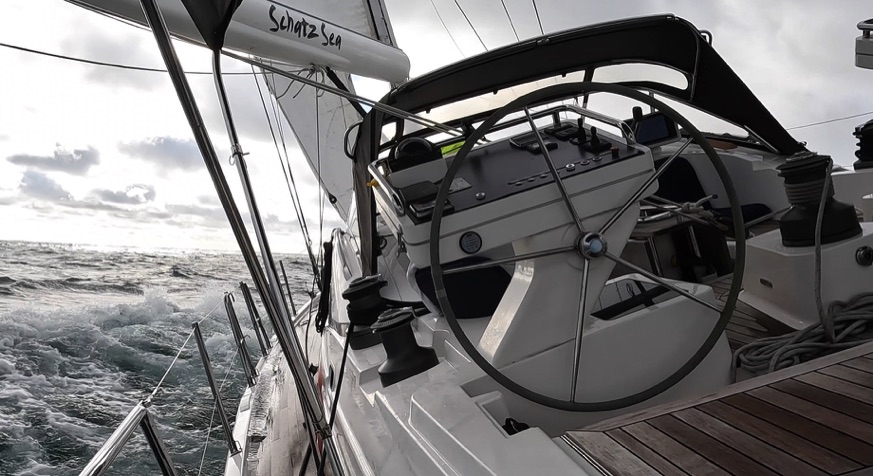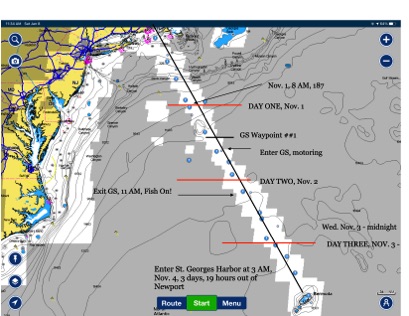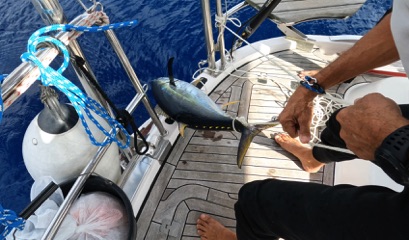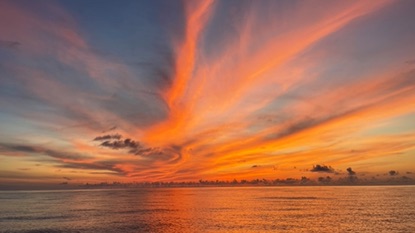By David H.Lyman
A brief version of this story appeared in the 2023 January-February edition
of Cruising World Magazine.
I have included my original text here.
Joining a Yacht Sailing South
I was standing with Hank Schmitt, at the OPO booth at last September’s (2021) Newport Boat Show. A couple stopped by looking for crew for an offshore delivery. That's when my life change.
Hank runs OPO, Offshore Passage Opportunities, a crewing network that matches owners and delivery skippers with his members who are looking to crew on and offshore delivery. Gregg and Katrin had bought a slightly used Southerly 54 that previous spring and were planning to sail it to the Caribbean in the NARC rally that fall. Hank also runs NARC Rally, and has for the past 20-plus years. More on that later. The couple were looking for crew for the voyage down. Gregg, a member of OPO, and had made a few offshore deliveries all ready, but Katrin, who grew on her fathers boats in Europe, had yet to make her first long offshore voyage. With a new (used) boat and limited offshore experience, Hank suggested they hire a pro skipper to mentor them on the way down. They had, but were looking for a fourth crew. That’s were I came in.
I’ve skippered my own boats to the Caribbean more than a dozen times and been paid to deliver a few others. I’ve known Hank for years and been on five of his NARC Rallies. Would I be interested in joining Gregg and Katrin as that fourth crew? They are a handsome couple, in their fifties, fit and personable. I was looking for a ride south this fall, and joining these two, especially on a Southerly 54, well . . . need I say more. Besides, since they already had a pro skipper, I’d be relieved of that responsibility. Maybe I could finally relax and enjoy the ride this time.
“Sure,” I said. And that begins this story.
Schatz Sea - the Southerly 54
I couldn’t find out much about this Southerly 54 on the internet. There was only one built, and that was one Gregg and Katrin’s now owned. I asked if I could come down to Boston, where they had the boat berthed, for a look-see. Sure. Spend the night. I did. Gregg and I went over the boat from stem to stern. I gave him my considered opition on a few additions he might make such as a second anchor on the bow.
“You’ll not spend much time at a dock in the Caribbean,” I told him. “You’ll be at anchor most of the time, and with two anchors, ready to go on the bow, you’ll feel better.” We looked at the steering system, the engine, main reefing and furling systems and the retractable keel mechanism. My first impression was this was one well thoughtout and designed yacht, in the same pool as the Halyas, Oysters, Discovery and other blue water passage-makers. I was beginning to look forward to sailing on her.
The yacht’s name is Schatz Sea. It’s a German thing, Schatz meaning “my beloved” or something like that. It’s a term of endearment. Katrin is from Germany. Gregg is an American. They've been together for nearly 30 years, with two grown sons. Retirement was a few months away.
The afternoon on the Schatz Sea with Gregg the was certainly beneficial for both of us. I got to see the boat, he got to see and listen to me. When Katrin arrived onboard, another aspect of yacht delivery kicked in, crew bonding. They are a gregarious couple, positive, full of life, looking forward to this pending adventure. I joined them and others in the marina community for their ”Sailing Away” party on a nearby boat. This was certainly a fun to be with couple. Now I was really looking forward to the adventure
Gregg and Katrin, like many nearing retirement, began looking for a world cruising boat a year ago. They were fortunate in this depleted market to find this Southerly. Built in 2014 in Southampton (UK) it was 8 years old, and looked new. Their previous boat was a 32-footer which they a coastal cruised in New England for few years. They had done their homework, knew what they were looking for, and while they did inspect a few Haylas and Oysters on the used market, the uniqueness and the build quality of this Southerly won them over. While there are many smaller Southerly yachts around, this was the only 54 they built before the company was acquired by their competition, Discovery, another Southampton yard, that makes similar yachts.
Preparations for an offshore voyage
Gregg and Katrin sailed Schatz Sea down to Newport in late October to prepare for the NARC Rally. As they entered the Bay, things began two come apart. The starboard helm wheel disconnected from the rudder linkage, the bow thruster failed, the boom furling system jammed and ripped the main sail. Fortunately, the Port helm still worked so they got the boat safely into a slip at Newport Yachting Center where the NARC Fleet was amassing.
I joined them on Wednesday to learn someone was coming to fix the bow thruster, the main sail had been removed was already at NorthSail for repair. Gregg had been into the steering system to find a lock nut had worked loose, and the bolt connecting the wheel to the rudder linkage had fallen out. Off to the hardware store we go to acquire another. Fixed. Boat-ownership requies an ability to fix things, jury-rig, make-do, improvise. Thursday, Dan Valoppi, the pro skipper arrive. Gregg and I go shopping.
I convince Gregg he needed fishing tackle on board. Off we go to Sam’s Bait and Tackle Shop, next to Pickle’s Deli, on Aquidneck Road. Sam has a good reel and a pole, each for $80, and 500 yards of 100-pound test mono-filoment line. I’d brought along my kit of lures, leaders and swivels.
“We’ll catch enough fish to pay back the investment in the run down to the islands,” I tell him. And we did.
The blow thruster fixed, the Maine sail repaired, returned and bent on and Katrin and I went shopping. By the time we check out, we’ve spend an hour and $800. There’s still the propane tanks and diesel tanks to top off, the weather briefing and the traditional Rally Crew dinner. The Friday weather and route briefing for all skippers tells us this should be the easies passage to Bermuda in years— as soon as this storm blows through by Sunday morning.,
Saturday’s departure is postponed. Good, one more day to prepare.
“You’ll have to contend with a residual SSEerly swells, 8 to 10 feet, left over from this current storm. The period is long, 8 seconds, but those will diminish over the day. The winds will continue to vier into the W, NW and N and drop. Monday, winds should be NW, 14 to 18 knots. The SE swells will be replace by SWerly swells, but on the beam.”
At least there were no systems coming off the coast to bother us as we neared Bermuda. It would be light winds most of the way
The First Leg: Newport to Bermuda
Sunday morning, October 31. “Water is on for Coffee,” Gregg announced as the crew assembles in the mess. There’s little to do, but eat, cast off lines and get going. Dan backs us out of the slip at 8:15.
I’d downloaded the Gulf Steam chart from Windy and picked out a possible entry point. The Stream, is a phenomena to contend with a narrow, fast flowing stream of warm tropical water that comes squirting up through the Florida straights, glances off Cape Hatterass’ shoal and heads East out into the Atlantic, to eventually warm the shores of Ireland and England. It’s a narrow stream of of fast moving tropical water that is a major concern for any boat, yacht, ship crossing it. Today’s satellite charts give precise information one the Stream velocity: speed and direction. We were fortunate this fall to have the stream take a southeast flowing meander, right on our rhumb line to Bermuda. All we needed to do was hop on the Stream as it turned SE and ride it for ten hours. exiting it when then Stream turned east and north again. We’d pick up an extra 3 to 4 knot kick.
We motored out of Newport with a dozen other NARC boats, to be met by a bisque SSW wind, blowing 15 knots up the Bay. The sky was filled with yesterday’s storm clouds, an ominous start to our 640 mils voyage to Bermuda. Off to the west, behind us was hint of open sky and a nicer day. We hoisted the main, half way, and unrolled the working jib on the inner Solent stay, tuned left at Breton Reef on a SE course and headed out into the Atlantic, chasing those storm clouds.
By noon it was still cold, the clouds had blown away. The sun was out. The boat was making 7 knots, the wind forward of the beam, climbing up and over yesterday’s SE swells, only to plunge down into the toughs. It was then, I realized, I’d not taken my Stugeron motion medication. I had to admit to myself, this old sea dog, with more than 80,000 offshore miles, was getting seasick. Embarrassing. Off watch, I lay on the seat in main cabin looking out the large windows at the horizon.
Seasickness is a bother. I’ve been sick before, and probably will be again. Get through it. This too shall pass. Takes 24 hours. Drink water. Throw up, rest, stand watch.
That first day at sea was a blur, waves, spray, wind increasing, heel increasing, boat bounding along. No one ate, except Skipper Dan. Katrin complained it was Saturday night’s pizza that did her in. I came into the cockpit for my 2 am watch, still sick, but able. The wind had gone into the N, 15 knots. The SE swells had moderated as to be un-noticeable. At 4 am, off watch, I went below to make a PBJ and felt better.
By Monday morning we’d traveled 190 miles, averaging nearly 8 knots. The day was sunny, winds northerly 12 knots. White, puffy clouds ahead told we were nearing the GS, which we entered around 2 that afternoon, 30 hours out of Newport.
Dan helped Gregg and Katrin rig the pole with the genoa so we could run wing-in-wing for a few hours. It was instructive to watch and listen to Dan walk the two through the process of rigging lines to the pole, getting it deployed, at the right angle to run the genoa off to port, the main prevented off to Starboard. I was impressed with Dan’s clear instructions and patience, and for Gregg and Katrin’s eagerness to learn, listen and accept Dan’s instructions, and work as a team. Dan is a volunteer instructor for the Warrior Sailing Program, that gets veterans out on the water. I’d see more of this in the days ahead.
The Stream was now pushing us along at 9 knots. The AIS showed five other NARC boat all with VHF range. Aspra, a Swam 61, off our starboard quarter, crossed behind us to parallel us off to port. Avocation, Song and Avocation were behind, moving up. That evening the AIS screen was vacant. We were alone. The winds had dropped, the sails wound in and we were under power.
That evening, everyone was now back to their normal selves. Seasickness, the wind and seas of Sunday, the Gulf Stream all now behind us, replaced with lot of good natured banter, joking, poking fun and teasing.
Put people together in a small space, mix in shared responsibility for each other, add in a dash of danger and soon true personalities emerge (sounds like the Navy). Katrin, a tall, statuesque German, had a more serious approach to this boating stuff. She’s a soon to be retired surgeon, cool in crisis (not that one had arrived yet), with the innate curiosity of a 12 year old girl. She was always bugging Dan or me about something. Gregg and Dan, I found were both bar tenders in previous lives. They were engaged in endless repartee, trowing off cynical quips, sage advise, and soulful truths. Me? I’m old enough to be their father, a working journalist, an observer. I sat and watched, listened.
Katrin and Gregg had been married for nearly 30 years, have two grown boys, and both were looking forward to Katrin’s retirement and a life aboard their boat.
Gregg had been a teacher for most their married life, and while this boat thing was her idea, she’d been sailing with her father since childhood, Gregg was fully on board. He’d joined OPO, Hank’s crew service a few years ago and had crewed for a few deliveries, been to Bermuda and back, and was a willing student to learn what Dan and I might impart. They both had owned and coastal 34-foot cruised before upgrading to the Southerly.
Schatz Sea was a complex set of systems and electronics. It had a lifting keel, which Dan referred to as a “center board.” The “in the boom” furling system was frustrating, but the head sails, with a Solent inner stay, was a delight to use. All push button from the cockpit, as was the main halyard and furling lines. Electric winches, autopilot, the boat could sail itself. These push-button systems were a bit much for me. I’m of the analog, manual, paper chart generation, but push-button winches sure are nice.
The more I got to experiences this Southerly the more I came to realize how well it was thought out, designed and manufactured. It didn’t groan or creek below in a seaway. There were hand-holds where you needed them. You could see the horizon seated at the dining table. The cockpit seats were long enough to sleep on, and the table large enough to seat seven. The only thing that I didn’t like was the upper and lower bunks on my cabin. They were so close together, you could not hold a book and read while in bed.
Excitement!
A lazy Tuesday afternoon. We’re just south of the Gulf stream, under power. The sky is clear, the sun is bright, its shorts and t-shirts. I’m on watch when my eye catches a splash to port, a boat lengths away, then another and another. It’s school tuna chasing bait fish to the surface. “Fish!” I yell, as everyone comes on deck. Moments later, the reel on the new fishing rod begins to sing. “Fish on! Fish On!” I yell and dash to the rod holder on port pushpin. I released the clicker, and begin tightening the brake, but the fish keeps stripping line. Dan slows the boat and put us in neutral. “Rum,” I yell. We’ll need rum.”
“For you or the fish?” Gregg questions, knowing full well what for.
The boat slows, the rod is bent over as the brake slows the reel. It’s five minutes before I can begin cranking in line. This is one big fish. I turn the reeling-in process over to Gregg. It’s his rod, and this will be his fish.
Half and hour later, the fish is near enough to see. It’s a yellow fin tuna. Crouched on the swim platform, Dan slips a tail rope down the leader wire and down around the fish in order to haul it aboard. We have no gaff and a fish brought on deck by the wire leader can break loose from its own weight. Once on the aft deck, the tuna is still full of life. It takes two of us to hold it still while Katrin administers the sedative. Once sedated, and the PhotoOP is completed, I ask Katrin, being a professional surgeon, if she would like to preform the autopsy. She declines and we all watch as Dan goes to work with his fillet knife. It’s a bloody mess, but once done and the decks are washed, we have nearly 15 pounds of tuna. “That fish just bought your rod and reel,” I add. We were still eating tuna when we reached the Islands two weeks later.
The sun sets. We motor on into the night. Tuna for dinner.
Friday morning begins our fourth day at sea. It’s less than 100 miles to Bermuda. We should be there by 4 am Saturday morning. The wind has clocked into the East, so we sail for the afternoon. By dusk, the wind is SE, 10 knots, 15 knots over the deck, In come the sails, and on goes the motor. The SE breeze has kicked up a chop and Schatz Sea shoulders into it, her flat bow pounding. I can’t sleep below so join everyone else in the cockpit as the loom of Bermuda’s lights raise above the horizon. Landfall is always a bitter sweet. Yes, to be ashore, out of the elements will be welcome, but part of me already misses the pristine existence out here on the sea. Life is similar, less complicated. No money to deal with, no emails, no demands other than the watch schedule.
I call Bermuda Radio on VHF 16, switch to 24, and tell them who and where we are. They ask if we are part of the NARC Rally. I say yes. “Standy by and call-in when you are near Mills Breaker,” a lighted beacon off Bermuda’s eastern reefs. Bermuda Radio is an old friend.
Dan takes us through the narrow Town Cut into St. George’s Harbour at 3 am. Bermuda Radio instructs us to anchor in Powder Hole, across from Town of St. George’s and clear Customs and immigrations in the morning.
Dan finds a suitable spot among a few late night arrivals. Gregg drops the hook and Katrin pops a cork. The boat is a rest, quiet, no motion. We are 4 days, 19 hours out of Newport. The fastest voyage I’ve made in 20. Maybe these modern cruising yachts are not as bad as I thought.
My story on the second leg of the Voyage South, Bermuda to Sint Marrtin, is on the next page.
Departing Newport, October 31, 2021 aboard Schatz Sea, a Southerly 54, bound for Bermuda, then the Triopics.

Offshore Bound!
The Fall 2021 NARC Rally to the Caribbean




